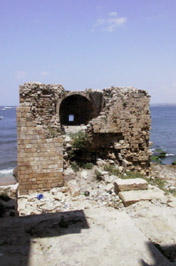
|
|||||||||
|
SOUR / TYRE |
|||||||||

|
Five Millennia of History Phoenician expansion began about 815 BC when traders from Tyre founded Carthage in North Africa. Eventually its colonies spread around the Mediterranean and Atlantic, bringing to the city a flourishing maritime trade. However, prosperity and power make their own enemies. Early in the 6th Century BC Nebuchadnezzar, King of Babylon, laid siege to the walled city for 13 years. Tyre stood firm, but it is probable that at this time the residents of the mainland city abandoned it for the safety of the Island. In 332 BC Alexander the Great set out to conquer this strategic coastal base in the war between the Greeks and the Persians. Unable to storm the city, he blockaded Tyre for 7 months. Again Tyre held on. But the conqueror used the debris of the abandoned mainland city to build a causeway and once within reach of the city walls, Alexander used his siege engines to batter and finally breach the fortifications. It is said that Alexander was so enraged at the Tyrians' defence and the loss of his men that he destroyed half the city. The towns' 30,000 residents were massacred or sold into slavery. Tyre and the whole of ancient Syria fell under Roman rule in 64 BC
None the less, for some time Tyre continued to mint its own silver coins.
The Romans built a great many important monuments in the city, including
an aqueduct, a triumphal arch and the largest hippodrome in antiquity.
Christianity figures in the history of Tyre, whose name is mentioned
in the New Testament. During the Byzantine era, the Archbishop of Tyre
was the Primate of all the bishops of Phoenicia. At this time the town
witnessed a second golden age as can be seen from the remains of its
buildings and the inscriptions in the Necropolis Taken by the Arab Muslem
armies in 634, the city offered no resistance and continued to prosper
under its new rulers, exporting sugar as well as objects made of pearl
and glass. With the decline of the Abbasid caliphate, Tyre acquired
some independence under the dynasty of the Banu 'Aqil, vassals of the
Egyptian Fatimides. This was a time when Tyre was adorned with fountains
and its bazaars were full of all kinds of merchandise, including carpets
and jewelry of gold and silver. Thanks to Tyre's strong fortifications
it was able to resist the onslaught of the Crusaders until 1124. After
about 180 years of Crusader rule, the Mamlukes re-took the city in 1291,
then passed it on to the Ottomans at the start of the 16th Century.
With the end of World War 1 Tyre was integrated into the new nation
of Lebanon. |
||||||||

990531/lbi